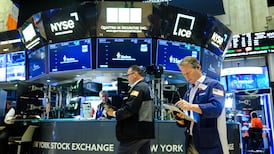SERIOUS MONEY:FEARS OF a double-dip continue to unnerve investors, and the latest slew of economic data provides little comfort. This is despite the assurances of President Barack Obama and Federal Reserve chief Ben Bernanke, who believe the fledgling recovery is on a sound footing.
Stock prices think otherwise, and mounting concerns of a premature end to the fiscally induced upturn has caused the major market indices to register a bearish death-cross; the 50-day moving average of closing prices has penetrated the 200-day moving average from above for the first time since the winter of 2007.
Could the politically motivated fanfare from Washington DC be wrong? Could the profit-motivated advocates on Wall Street with their perennial bullishness be wide of the mark?
The history books side with the bulls and confirm that double-dip recessions are rare. Indeed, there is only one example in modern US history; the painful downturn that began in the summer of 1981 called an end to the nascent recovery that began 12 months earlier, as former Fed chairman Paul Volcker launched a harsh but ultimately successful assault on the US economy’s ingrained inflation mentality.
The annals of history do not lie, but can be discounted given that the US has never before been weighed down by so much debt – and the latest data paint a picture of an ailing economy struggling to stay above water.
Economic data has disappointed almost uniformly in recent weeks. The reports speak for themselves. Consider but a few – consumer confidence tanked last month, retail sales registered their first decline since last autumn, new home sales plunged to a record low and the excess supply of homes surged to 8½ months.
All this negative data confirms a flat-lining economy. The closely watched monthly employment report corroborated the fears; its more reliable household survey at inflection points revealed that 322,000 jobs were lost last month and 563,000 over the last 12 months. The unemployment rate did drop a few tenths of 1 per cent last month, but only because of the second-steepest drop in those deemed eligible for work in 15 years.
It’s hardly surprising in this context that year-on-year wage gains continue south and the self-sustaining recovery consensus view is being called into question.
The picture painted by the data is all well and good, but the clipping of GDP forecasts based on the rear-view mirror won’t lead to superior investment performance, no more than a coin-toss competition will produce an infallible gambler.
Financial markets anticipate the future, and the focus must switch to forward-looking indicators to divine the months ahead. Unfortunately, the outlook does not look good.
The Economic Cycle Research Institute’s (ECRI’s) weekly leading index is undoubtedly the flavour of the month and, although it has been subjected to some criticism from purists in the world of statistics, the signal relayed now is pretty clear. The index has dropped to its lowest level in almost a year, and the growth rate of the said indicator is now in recession territory. The current reading, at minus 7.7 per cent, has always pre-empted or accompanied an economic downturn in the past. In spite of protestations from the perennial bulls, it is hard to find a reason why now will prove any different.
The ECRI’s index is clearly a valid warning signal for near-term economic growth, but how does it do as a predictor of stock market performance? The sample is quite small given that the growth index has dropped only six times in the index’s more than 40-year history.
The results may not be altogether reliable, given the few observations, but they reveal that stock prices typically drop by 10 per cent in the six months that follow readings of the current magnitude.
However, it must be noted that stock prices staged a meaningful rally in both 1980 and 1990, as the indicator registered a similar reading quite late during what were to be quite shallow recessions.
Perhaps the “death-cross” does better than the ECRI index; the answer is no, in spite of the protestations of those who get paid well for drawing charts. Stock prices typically remain weak for no more than weeks after the technician’s bearish dreams are fulfilled.
In fact, beyond a six-month horizon, the so- called bearish signal has no predictive ability whatsoever. It is quite clear that the world’s largest economy is rolling over; even a casual analysis of the fundamentals would reveal that this is no surprise.
Technical indicators reveal that the much- maligned double-dip is already in progress. Stock prices are forward-looking, and it is the call for the economy in 2011 that matters now. The dance around zero should come as no surprise to anyone in a deleveraging developed world. Welcome to the new normal.
www.charliefell.com










